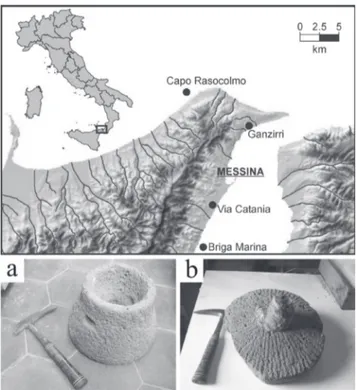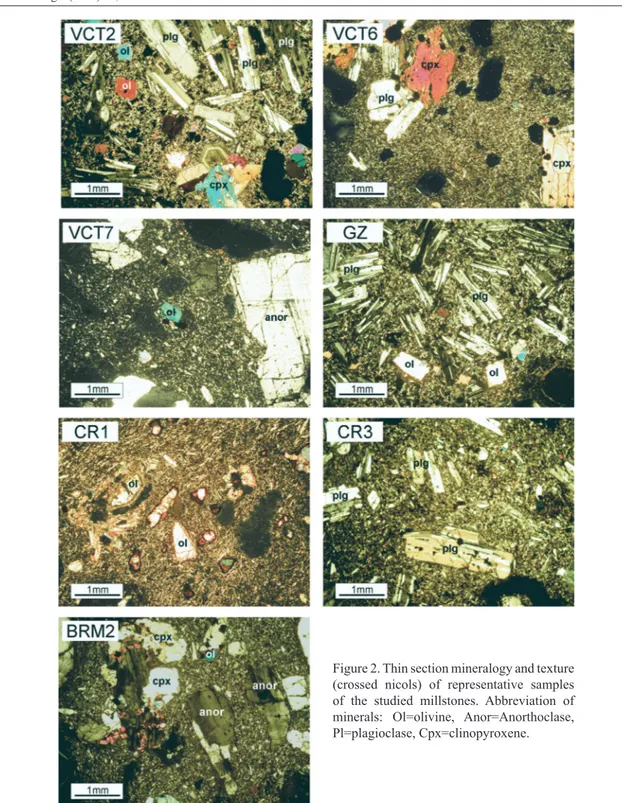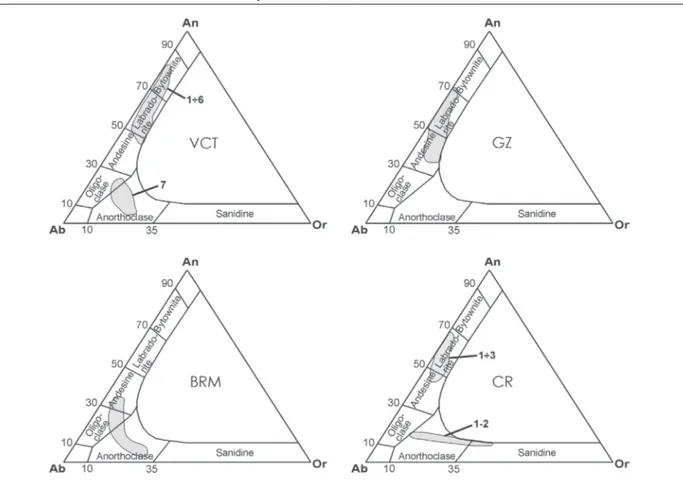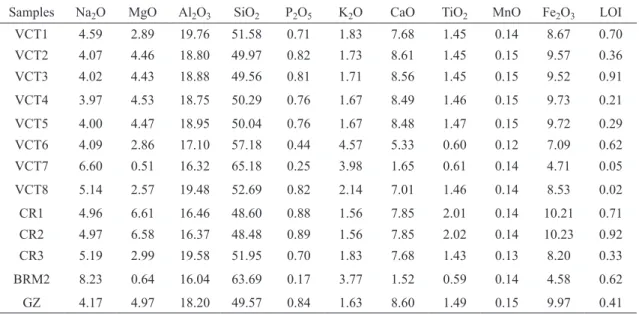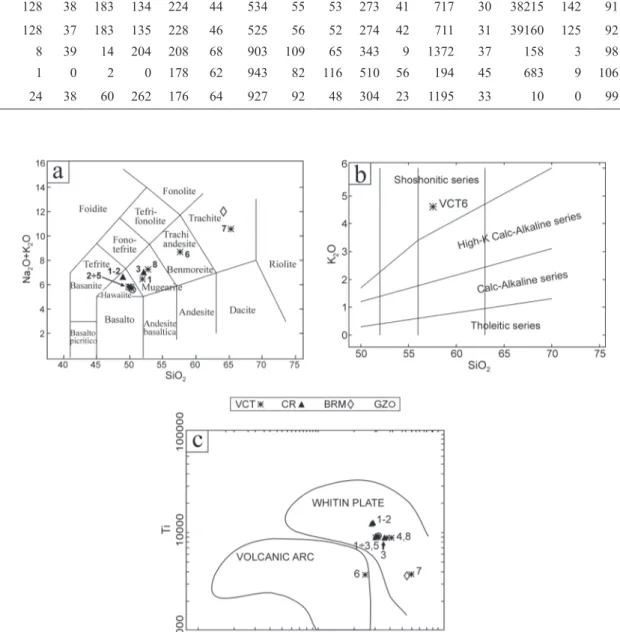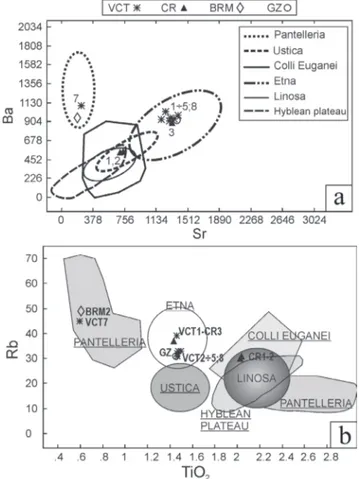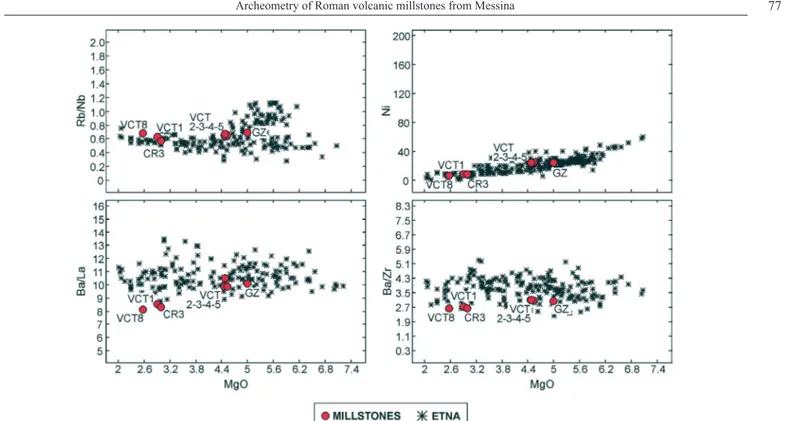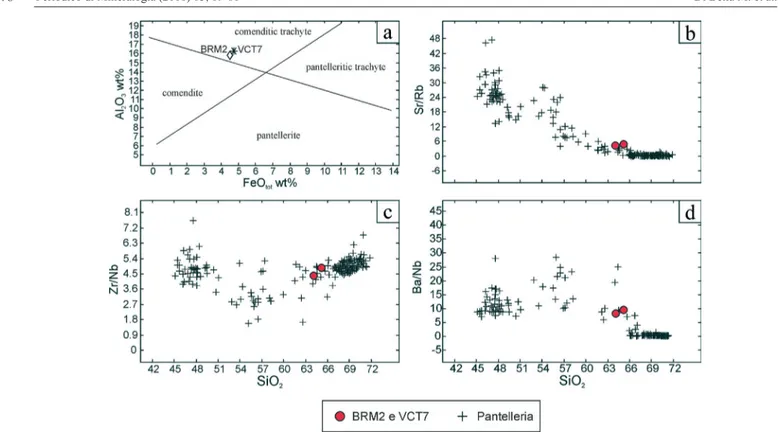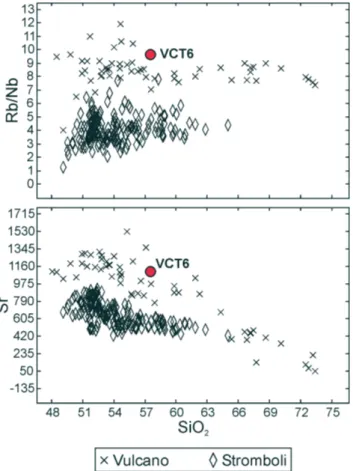An International Journal of
Mineralogy, Crystallography, Geochemistry, Ore Deposits, Petrology, Volcanology
and applied topics on Environment, Archaeometry and Cultural Heritage PERIODICO di MINERALOGIA
established in 1930
Archaeometric characterization of Roman volcanic millstones
from Messina territory (Sicily, Italy)
Marcella Di Bella a,*, Paolo Mazzoleni b, Selma Russo a, Giuseppe Sabatino a, Gabriella Tigano c, Alessandro Tripodo a
a Department of Mathematics, Computer Sciences, Physics and Earth Sciences of the Messina University, Italy
b Department of Biological, Geological, and Environmental Sciences of the Catania University, Italy c Soprintendenza ai BB.CC.AA. of Messina, Italy
INTRODUCTION
This work aims to broaden the knowledge about a type of archaeological objects represented by volcanic millstones coming from the Roman archaeological sites of Messina. The archaeometric analysis comprises the petrochemical characterization of the lithologies used for their construction and the provenance attribution of the raw materials.
Particular attention was devoted to the choice of the lava stone quarry that provided grinders being - at the same time - hold and resistant to abrasion. Most of these artefacts were obtained from vesicular volcanic rocks, selected for their textural and physical characteristics, as elevated strength, hardness and good porosity, workability and transportability. Furthermore, for their high specific weight, the great millstones were frequently reused as ballast weights on the ships. This peculiar use is testified by archaeological finds occurred on shipwrecks; two cases in the Messina area are examined in this study.
The archaeometric study of Roman millstones from archaeological sites in the Mediterranean area is an important tool for identifying the production sites and tracing the historic trade routes (Childe, 1943; Thorpe and Thorpe, 1990; 1993; Curtis, 2001; Santi et al., 2004; Williams and Peacock, 2011). Many authors recognized numerous Mediterranean areas - especially during the Roman period - exploited for the quarrying of volcanic rock suitable for the production of cereals millstones. The main examples are located in Spain, Germany, France, Italy, Portugal, Morocco, Tunisia, Libya and Turkey (Williams-Thorpe, 1988). As concerns Italy, the most important areas, from the North towards the South Italy, were Euganean Hills (Veneto), Vulsini Volcanic District (Latium and Umbria), Orvieto region (Umbria), Somma-Vesuvius (Campania), Monte Vulture Volcano (Basilicata), Oligocene-Miocene and Pliocene-Pleistocene Sardinian volcanic areas, and many areas of Sicily, including Mt. Etna, Hyblean Hills, ABSTRACT
This paper presents the results of a petrochemical study of Roman millstones for cereal production, made of volcanic rocks, which were found in several archaeological areas of Messina territory. Thirteen samples dating from the III century AD and one dating from the II-III centuries AD were characterized through petrographic and geochemical investigations. The raw materials of the studied millstones are mainly volcanic rocks characterized by Na-alkaline affinity with intraplate geochemical signature. Only one sample belongs to the K-alkaline series and shows a volcanic arc signature. The comparison with literature data on similar rocks allowed constraining the volcanic origin of the exploited lavas. The intraplate samples are mostly mugearites and benmoreites from Mt. Etna (Sicily, Italy), and only in few cases peralkaline-trachyte and alkaline basalt from Pantelleria and Linosa islands (Sicily), respectively. The arc-type sample derived instead from islands of the Aeolian Archipelago. Keywords: Archaeometry; Roman Age; millstone; volcanic rock; petrography; SEM-EDS; XRF.
ARTICLE INFO
Submitted: May 2015 Accepted: February 2016 Available on line: February 2016 * Corresponding author:
[email protected] DOI: 10.2451/2015PM471 How to cite this article: Di Bella M. et al. (2016) Period. Mineral. 85, 69-81
Pantelleria, Ustica and Aeolian Islands (Ferla, 1984; Daniele, 1997; Antonelli and Lazzarini, 2010; Santi et al., 2013; 2015; Gluhak and Schwall, 2015).
Thorpe and Thorpe (1990; 1993; 2001) provided a map of the millstones distribution in the Eastern Mediterranean basin, from which the large amount of sites existing in Sicily with respect to the rest of Italy is clearly evident. Moreover, this map shows that, especially during the Imperial Age, the millstones were widely commercialized towards and from various provinces of the Roman Empire.
Several authors studied millstones coming both from Italian and foreign archaeological sites. Antonelli et al. (2001) and Santi et al. (2004) provided the first clear evidence of significant petrographic-archaeometric differences between the leucite-bearing lavas from Orvieto region and other similar lavas of the Roman Magmatic Province, possibly used for millstone manufacture. Renzulli et al. (2002) attributed different provenance to the lithic materials of their study (from Euganean Hills, Mt. Etna and Hyblean Hills) showing that in the Roman period there was a well-organized trade of millstones in the Italian Peninsula. Gluhak and Schwall (2015) and Antonelli et al. (2005) identified the origin of millstones from Libya (Leptis Magna and Cyrene), from quarries of Orvieto, Mt. Etna, Pantelleria and minor volcanic areas of Central Libya. Antonelli et al. (2004) and Antonelli and Lazzarini (2012) demonstrated the use of Euganean trachyte and basic lavas from Mt. Etna in Slovenia and Croatia, and of materials from Pantelleria and Etnean volcanics to produce millstones found in the Friuli region, confirming again the flourishing trade existing during the Imperial Age in the Mediterranean area and the wide use of Italian volcanic rocks as raw materials to manufacture these objects. Santi et al. (2013; 2015) studied the volcanic millstones from the Archaeological site of Morgantina (Sicily) of the Greek and Roman periods found in the Aeolian Archipelago (Southern Italy), providing information about provenance and evolution of the milling techniques in the Mediterranean area. Gluhak and Schwall (2015) constrained the possible provenance of the volcanic rock grinding stones from the Greek colony of Selinunte, Sicily (Italy).
In this context, the aim of the present work is to contribute to the knowledge on the provenance of millstone rocks through mineralogical, petrographic and geochemical investigations of millstone fragments.
ARCHAEOLOGICAL SITES
The studied archaeological objects include various typologies of millstones, ranging from the manual mills to the more technological millstones driven by animal traction. They range in age from the III century BC to the seventh century AD, and come from several archaeological sites of Messina Municipality (Figure 1), briefly described below:
-The site of Via Catania was the first residential settlement in Messina. It is characterized by a complex history that includes phases of construction, reconstruction, expansion and abandonment, taking place in a time spanning between the first half of the third century BC and the beginning of the third century AD. The site is located near Gazzi Village, at the foot of the eastern slope of the Peloritani Mountains. Different archaeological remains were found: various types of ceramics, glasses, metal slags, etc. as well as several fragments of lava millstones (including a metae; Figure 1a) most of which reused to build walls and internal structures (Bonanno, 2001).
-The site of Ganzirri is a Late Roman - Proto Byzantine settlement, found in the Village of Ganzirri, ten kilometers north of Messina City. The structural characteristics (walls, houses, planimetric variations, etc; Tigano, 2001) suggest the use of such dwellings from the late fourth century AD up to the first Byzantine period. The material recovered includes abundant fine ceramic tableware, coins, lamps, glass objects, and, especially, stemware, small bronze objects and elements of millstone (Figure 1b; Tigano, 2001).
-The Capo Rasocolmo Relict shipwreck was found in August 1991 at Rasocolmo Cape, along the Tyrrhenian coast of the Messina Municipality. The shipwreck lies on a shallow gravelly seabed just a few meters from the coast.
Figure 1. Location sketch map of the archaeological sites of Messina and representative photographs of the studied millstones; a) rotating hand mill (sample VCT5) and b) catillus of Pompeian style millstone from Briga Marina shipwreck (sample BRM2).
It returned only metal parts of its composition, especially with copper nails and other functional elements, as well as on-board equipment, as for instance an anchor of iron. The shipment consisted of a group of fifteen lava millstone elements, especially catillus (Figure 1a), probably used as ballast, from a lead ingot of Spanish origin, and from other small objects, including coins (Bacci, 2001).
-The Briga Marina Relict shipwreck was found off the coast of Briga Marina Village, about 15 km south of the Messina city. The results of the first survey (September 1991), highlighted the presence of fire ceramics and other kitchen utensils dated to the first half of III century BC and the beginning of III century AD, until the next century. Initially, it was assumed that the ship cargo was formed only by fire ceramics, but later other objects, including some cereal mills, were found (Lentini, 2001).
SAMPLING AND ANALYTICAL METHODS
Thirteen fragments of millstones, all dated to the Roman period, were kindly provided by the Soprintendenza BB.CC. of Messina. The samples are grouped in two series. The first series includes eight samples of “rotating hand” mills, coming from the archaeological site of Via Catania (VCT1÷VCT8) and one from the site of Ganzirri (GZ). The second group includes four samples of “rotary Morgantina-type” millstones, three “catilli” from the Capo Rasocolmo shipwreck (CR1, CR2, CR3) and one sample of “meta” from the Briga Marina shipwreck (BRM2). From each fragment of the studied millstones, the corresponding thin section and powder sample were prepared and analyzed at the laboratories of the Dipartimento di Scienze Matematiche e Informatiche, Scienze Fisiche e Scienze della Terra (MIFT) of the Messina University. The thin sections were used for the mineralogical and petrographic studies through an optical microscopy and a Scanning Electron Microscopy LEO-S420 coupled to an Oxford link ISIS series 3000 EDX spectrometer and Si(Li) detector with resolution of 156 eV at MnKα. The spectral data were acquired at 1500 to 2000 counts/s with dead time below 25%, using the ZAF correction. SEM-EDX analyses were performed operating at working distance of 19 mm, at acceleration voltage of 20 kV and 550 pa (PROBE).
The powder samples were examined at the Dipartimento di Scienze Chimiche e Geologiche of Modena and Reggio Emilia University by means of X-ray Fluorescence analysis, in order to establish the whole rock chemistry (major and trace elements).
The samples were crushed in a steel jaw crusher and reduced to a fine powder in agate mortars. SiO2, TiO2, Al2O3, Fe2O3, MnO, CaO, K2O, P2O5, Nb, Zr, Y, Sr, Rb, Ba, Cr, V, and Ni were analysed by X-ray fluorescence on powder pellets using a wavelength-dispersive automated Philips PW 1400 spectrometer. MgO and Na2O concentrations
were determined by atomic absorption spectrophotometry and flame emission on sample solution after perchloric and hydrofluoric acid attack. FeO was determined by titration after rapid HF-H2SO4 attack. LOI (Loss on Ignition) is the weight loss after heating at 950 °C. Concentrations of each element were calculated using the method proposed by Franzini and Leoni (1972), based on correction of matrix effects. The analytical precision is 0.3% for Si and 0.1% for other major elements. For trace elements the analytical precision is ±5% for Rb and Sr, 10% for others.
ANALYTICAL RESULTS Petrography
In general, the studied samples (Figure 2) are characterized by a variable porphyritic index - from medium to high - with abundant vacuoles and more generations of phenocrysts, including plagioclase, olivine and pyroxene. The intersertal groundmass consists of the same phases present as phenocrysts, with frequent prevalence of plagioclase microliths. The compositions of the main analyzed mineral phases are reported in the relative classification diagram shown in Figure 3 and Figure 4.
The first series of samples (VCT=Via Catania and GZ=Ganzirri) can be subdivided in two sub-groups. The main group includes the samples VCT1, VCT2, VCT3, VCT4, VCT5, VCT8 and GZ, which are generally very porphyritic (PI 25-40), slightly vesicular and characterized by fresh appearance and dark-grey color. VCT1, VCT8 and GZ show abundant and frequently oriented feldspar phenocrysts (6-8 mm sized). They are composed of prevalent plagioclase and variable amount of clinopyroxene and olivine phenocrysts immersed in a microcrystalline-intergranular, locally trachytic, groundmass made of plagioclase>Fe-Ti oxides>clinopyroxene±olivine. The second group, including VCT6 and VCT7, shows a different texture with a medium-low porphyritic index (PI 15-20), a smaller amount of plagioclase phenocrysts and prevalent pyroxene. The sample VCT7 is characterized by large corroded, often fractured, phenocrysts of anorthoclase. The plagioclase of this series is represented by heuedral and frequently zoned phenocrysts with bytownitic to andesinic compositions. The sample VCT7 is characterized by oligoclase and anorthoclase, typical of differentiated rocks. Clinopyroxene is green-brown, zoned, often twinned, and frequently forming glomeroporphiric aggregates with plagioclase and/or olivine. It is generally diopsidic and augitic in composition, with the exception of sample VCT7 that exhibits a Fe-rich augitic pyroxene. Olivine is present in fresh heuedral phenocrysts, Mg-rich (Fo≈80%), with edges and microliths more enriched in fayalitic component (Fo≈50%).
The samples CR1 and CR2, belonging to the Capo Rasocolmo series, show the same composition and seriate
texture, with medium-high porphyritic index (PI 25-35) and low amount of vacuoles. Phenocrysts consist of small to medium-sized olivine (Fo 80-63) with subordinate pyroxene and plagioclase. Pyroxene is enriched in diopsidic component with few augitic terms. Plagioclase is prevalently labradoritic to andesinic in composition; few anorthoclasic and sanidinic terms were also found. The high olivine amount gives a cumulitic aspect to these
rocks. Along edges and fractures, the olivine crystals are frequently replaced by iddingsite.
The sample CR3 differs from the previous samples of this series for a greater amount of labradoritic plagioclase phenocrysts, the scarce clinopyroxene (diopsidic and augitic) and the rare olivine. It shows a structure very similar to the main group of the VCT series.
Sample BRM2 from the Briga Marina relict is very
Figure 2. Thin section mineralogy and texture (crossed nicols) of representative samples of the studied millstones. Abbreviation of minerals: Ol=olivine, Anor=Anorthoclase, Pl=plagioclase, Cpx=clinopyroxene.
Figure 3. Classification diagrams of feldspars analyzed for the studied samples.
similar to the sample VCT7. It is characterized by abundant phenocrysts of twinned feldspars (oligoclase and anorthoclase), showing sub-euhedral resorbed habitus. Micro-phenocrysts of olivine, characterized by low forsterite content (Fo 27-22), and Fe-rich augitic clinopyroxene form together with feldspars, glomeroporfiric aggregates. Geochemistry
The major and trace element compositions of the studied samples are reported in Tables 1 and 2, respectively. The samples VCT1, VCT2, VCT3, VCT4, VCT5, VCT7, VCT8, CR1, CR2, CR3, BRM2, GZ show sodic alkaline affinity. Otherwise, VCT6 is characterized by potassium affinity, according to Le Maitre (2002) classification. On the basis of TAS classification (Le Bas et al., 1986), Figure 5a evidences that, among the sodic alkaline samples, CR1, CR2, GZ, VCT2, VCT3, VCT4, VCT5 are hawaiites, VCT1, VCT8, CR3 are mugearites, and BRM2 and VCT7 are trachytes. The potassic alkaline sample VCT6 is a trachy-andesite that, in the SiO2 vs K2O diagram of Figure 5b, falls in the field of shoshonitic series.
As regards the trace element content, the abundances of incompatible trace elements relative to the studied mafic samples are showed in the spider diagrams of Figures 6a and b. Data were normalized with respect to the composition of the primordial mantle of McDonough et al. (1992). All the mafic sodic alkaline samples (hawaiites and mugearites) show a bell-shaped pattern, with positive anomaly of Nb and a general enrichment in HFS elements, indicating an intraplate environment provenance of these rocks (Peccerillo, 2005). A confirmation of the tectonic environment has been obtained using the Zr vs Ti
discrimination diagram of Pearce and Cann (1973, Figure 5c). On this diagram the samples VCT1, VCT2, VCT3, VCT4, VCT5, VCT7, VCT8, CR1, CR2, CR3, BRM2 and GZ occupy the area of within-plate volcanics, whereas the VCT6 the area of volcanic arc rocks.
DISCUSSION
Old and recent works have established a useful petrological and historical database on the areas of provenance of the millstones used in the Mediterranean countries from the Neolithic to the Roman periods (Antonelli and Lazzarini, 2010, and references therein). The probable origin of the Messina millstones has been determined on the basis of the mineralogical composition and the geochemical signatures, according to the discriminative geochemical diagrams used in igneous petrology. Thereafter, analytical data of the two identified groups of samples were compared with those of similar rocks (Peccerillo, 2005) with the aim to verify the provenance area of the used raw rocks.
Provenance of intraplate samples
The samples classified as intraplate or anorogenic were compared with Italian rocks characterized by the same geochemical signature. In Italy, sodic alkaline rocks are present in Sardinia, Sicily (Mt. Etna, Hyblean Hills), islands and seamounts of the Sicily Channel and Ustica, and in the old volcanic districts of the Venetian Province and of Punta delle Pietre Nere (Apulia).
For a first discrimination, the data of the studied anorogenic samples were plotted on the Ba vs Sr classification diagram of Figure 7a, proposed by Antonelli and Lazzarini (2010) for the most important basic to intermediate Italian lavas.
Samples Na2O MgO Al2O3 SiO2 P2O5 K2O CaO TiO2 MnO Fe2O3 LOI
VCT1 4.59 2.89 19.76 51.58 0.71 1.83 7.68 1.45 0.14 8.67 0.70 VCT2 4.07 4.46 18.80 49.97 0.82 1.73 8.61 1.45 0.15 9.57 0.36 VCT3 4.02 4.43 18.88 49.56 0.81 1.71 8.56 1.45 0.15 9.52 0.91 VCT4 3.97 4.53 18.75 50.29 0.76 1.67 8.49 1.46 0.15 9.73 0.21 VCT5 4.00 4.47 18.95 50.04 0.76 1.67 8.48 1.47 0.15 9.72 0.29 VCT6 4.09 2.86 17.10 57.18 0.44 4.57 5.33 0.60 0.12 7.09 0.62 VCT7 6.60 0.51 16.32 65.18 0.25 3.98 1.65 0.61 0.14 4.71 0.05 VCT8 5.14 2.57 19.48 52.69 0.82 2.14 7.01 1.46 0.14 8.53 0.02 CR1 4.96 6.61 16.46 48.60 0.88 1.56 7.85 2.01 0.14 10.21 0.71 CR2 4.97 6.58 16.37 48.48 0.89 1.56 7.85 2.02 0.14 10.23 0.92 CR3 5.19 2.99 19.58 51.95 0.70 1.83 7.68 1.43 0.13 8.20 0.33 BRM2 8.23 0.64 16.04 63.69 0.17 3.77 1.52 0.59 0.14 4.58 0.62 GZ 4.17 4.97 18.20 49.57 0.84 1.63 8.60 1.49 0.15 9.97 0.41
Samples Ni Co Cr V Ce Nd Ba La Nb Zr Y Sr Rb Pb As Zn Cu VCT1 8 27 16 201 212 75 973 114 62 357 27 1403 39 9 0 87 43 VCT2 24 39 61 247 178 60 913 91 49 294 25 1315 31 11 0 84 80 VCT3 24 37 62 248 173 60 909 92 48 293 23 1296 31 15 0 84 80 VCT4 25 38 58 249 178 63 926 94 49 303 24 1344 32 230 0 91 78 VCT5 24 37 58 250 176 62 935 89 49 303 24 1329 33 220 6 88 77 VCT6 11 27 28 172 129 43 852 62 17 242 23 1111 164 21 1 73 72 VCT7 4 0 4 0 173 65 1085 88 115 558 49 234 48 10 0 101 2 VCT8 7 26 14 189 226 78 1016 125 67 388 31 1248 46 13 0 99 36 CR1 128 38 183 134 224 44 534 55 53 273 41 717 30 38215 142 91 58 CR2 128 37 183 135 228 46 525 56 52 274 42 711 31 39160 125 92 56 CR3 8 39 14 204 208 68 903 109 65 343 9 1372 37 158 3 98 61 BRM2 1 0 2 0 178 62 943 82 116 510 56 194 45 683 9 106 0 GZ 24 38 60 262 176 64 927 92 48 304 23 1195 33 10 0 99 63
Table 2. XRF trace element data (ppm) of the studied millestones samples.
Figure 5. a) Total alkali vs silica diagram of Le Bas et al. (1986); b) SiO2 vs K2O diagram of Peccerillo and Taylor (1976); c) Zr versus Ti tectonic discrimination diagram of Pearce and Cann (1973).
It includes the areas of Mt. Etna basalts and hawaiites and rocks from Pantelleria, Ustica and Hyblean Plateau. The areas of volcanics from Linosa (data from Peccerillo, 2005) and Euganean Hills (Milani, 1999) are added after the results of this study. On this diagram, VCT1, VCT2, VCT3, VCT4, VCT5, VCT8, CR3 and GZ samples fall in the area of Mt. Etna products, CR1 and CR2 samples fall in the overlapping field of the products of Euganean Hills, Hyblean Plateau, Linosa and Ustica, while VCT7 and BRM2 plot among the rocks of Pantelleria Island.
Afterwards, to better discriminate the provenance, Rb vs TiO2 diagram was used (Figure 7b). This diagram confirms the provenance of VCT1, VCT2, VCT3, VCT4, VCT5, VCT8, CR3, GZ samples from Mt. Etna, of CR1 and CR2 samples from Linosa Island or Euganean Hills and of BRM2 and VCT7 from Pantelleria Island.
From the previous diagrams, samples VCT1, VCT2, VCT3, VCT4, VCT5, VCT8, CR3 and GZ may be considered belonging to the hawaiitic and mugearitic rocks of Mt. Etna since they show a satisfying petrographic and geochemical compatibility (Gillot et al., 1994; Corsaro and Cristofolini, 2000; Branca et al., 2004; Peccerillo, 2005). The Etna hawaiites and mugearites - compositionally similar to the studied samples - generally are from grey to dark grey in color, are slightly vesicular and seriate and often are
characterized by an 30-50% hawaiites and 20-60% for mugearites.
As summarized by Antonelli and Lazzarini (2010) on the basis of literature data (Cristofolini and Romano, 1982; Cristofolini et al., 1991; Peccerillo, 2005) the studied alkaline rocks are characterized by a geochemical signature with low TiO2 values (<2 wt%) and high Sr (>1000 ppm) and Ba (>700 ppm) abundances (Cristofolini and Romano, 1982; Cristofolini et al., 1991; Peccerillo, 2005). Furthermore, these alkaline rocks show a bell-shaped pattern of primordial mantle normalized incompatible elements, characterized by negative anomalies of K, Hf and Ti and positive anomalies of Nb and Ta (Peccerillo, 2005). The LILE/HFSE, LILE/LILE and HFSE/HFSE ratios are quite similar. In fact, hawaiites and mugearites from Mt. Etna show average ratios between Ba/Zr=2-6, Rb/Nb=0.5-0.7 and Ba/La=9-12. The studied samples show very similar values of Ba/Zr~2-3, Rb/Nb~0.65 and Ba/La~9; also Ni values are comparable (Figure 8).
The trachite samples (BRM2, VCT7) should come from Pantelleria, the island located in the Sicily Channel. The island
Figure 6. Spider diagrams of incompatible trace elements normalized to the primordial mantle of McDonough et al. (1992) relative to the mafic studied millstone samples.
Figure 7. Discrimination diagrams: a) Sr vs Ba by Antonelli et al. (2010), modified in this study and b) TiO2 vs Rb.
is the emerged part of a stratovolcano and mainly consists of peralkaline trachytic rocks and rhyolites (pantellerite; Peccerillo, 2005). These felsic rocks are peralkaline and classified as comendites (comenditic trachytes, comendites and rhyolites) and pantellerites (pantelleritic trachytes and pantelleritic rhyolites) according to the Al2O3 vs FeOtot classification of Macdonald (1974). The samples BRM2 and VCT7 are comenditic trachytes (Figure 9a) characterized, as the pantelleritic ones, by porphyritic structure and variable amounts of clinopyroxene, fayalitic olivine, alkali feldspars phenocrysts, plus Fe-Ti oxides, included in a groundmass of the same mineral phases. As the rocks of Pantelleria, the investigated samples show a convex pattern with positive anomalies of Nb and Ba and negative spike of Sr. Sr/Rb, Zr/ Nb and Ba/Nb ratios are almost comparable with those of Pantelleria evolved rocks (Figure 9 b,c,d).
CR1 and CR2 millstones from Capo Rasocolmo shipwreck are hawaiites, showing affinity with volcanic rocks of Linosa island, located in the Sicily Channel Rift Zone at about 120 km south-east of Pantelleria. A provenance from the Euganean Hills is excluded because this volcanism originated prevalent evolved riolitic and trachitic products. The Linosa rock compositions range from alkali basalts to hawaiites, with subordinate evolved benmoreitic and trachytes. The hawaiites are characterized by phenocrysts of clinopyroxene, olivine (Fo 80-72) and plagioclase (An 75-60), with rare amphibole immerged in a microcrystalline
groundmass containing the same mineral phases present in phenocrysts plus opaque minerals. The content in major and trace elements (Figure 10) shows an increase in Al2O3, Na2O, K2O and incompatible trace elements (Th, Nb, Zr, REE) and a decrease in TiO2, MgO, Cr and Ni from basalt to trachyte (Rossi et al., 1996; Bindi et al., 2002). CR1 and CR2 show unusually elevated values of Pb because they were found in contact with metallic anchors. The spider diagram of trace incompatible elements (Figure 6), shows a bell-shaped pattern with positive anomalies of Nb and Ta (Peccerillo, 2005). The mineralogical and trace element composition of the CR1 and CR2 samples are fully comparable with those of Linosa, as evidenced by Figure 10 in which some trace element ratios are reported.
Provenance of volcanic arc sample
Sample VCT6 (Via Catania series) shows subduction related geochemical signature, hence it was compared with the possible main volcanic arc rocks of the Mediterranean Area, belonging to the Eolian and Aegean Arcs. The comparison with literature data shows affinity with rocks of the Eolian Arc (Figure 11). This is divided into a western, a central and an eastern sector. The western portion of the arc - including Alicudi, Filicudi and Salina Islands - is formed by mafic and intermediate and subordinately silicic calc-alkaline rocks. The central portion - represented by Vulcano and Lipari Islands -is characterized by calc-alkaline to
Figure 8. Rb/Nb, Ba/La, Ba/Zr and Ni vs MgO variation diagrams of the studied millstones on which literature data (from Peccerillo, 2005) of Mt. Etna volcanics were plotted for comparison.
Figure 9. a) Al2O3 vs FeOtot classification diagram of Macdonald (1974); b), c) and d) Sr/Rb, Zr/Nb and Ba/Nb vs SiO2 variation diagrams of BRM2 and VCT7 samples on which literature data (from Peccerillo, 2005) of Pantelleria island were plotted for comparison.
Figure 10 - Ba/Zr, Zr/Nb, Sr/Rb and Rb/Nb vs MgO variation diagrams of CR1 and CR2 samples on which literature data (from Peccerillo, 2005) of Linosa island were plotted for comparison.
shoshonitic mafic to silicic rocks. The eastern Panarea and Stromboli Islands consist of calc-alkaline to potassic alkaline rocks (Peccerillo, 2005).
The shoshonitic-andesitic trachy-basalt VCT6, was compared with similar rocks from Stromboli and Vulcano (Figure 12). These two islands show a rock composition ranging from mafic to silicic, with high-K calc-alkaline to shoshonitic to potassic alkaline affinity. The comparison evidences strong similarity between VCT6 and the shoshonitic HK rocks from Vulcano Island (Fossa Caldera Rocks, after Peccerillo, 2005). The rocks from La Fossa caldera are characterized by porphyritic textures with phenocrysts of labradoritic plagioclase, clinopyroxenes and magnetite set in a microcrystalline to hypocristalline groundmass; olivine and k-feldspar only present in some samples. Concentration values of Sr and Rb of Vulcano VCT6 sample, that are respectively of 1111 and 164 ppm, perfectly fit with values showed by shoshonitic HK rocks from characterized by values of about Sr=1212 and Rb=153 ppm.
CONCLUDING REMARKS
Williams-Thorpe (1988) highlighted the use of rocks from Mt. Etna and of other volcanic sodic alkaline islands of Sicily (Pantelleria and Ustica to a lesser extent) for the production of objects aimed to grinding cereals already from the Bronze Age (Ferla et al., 1984). Furthermore, recent studies (Williams-Thorpe, 1988; Volterra and Hancock, 1994; Lorenzoni et al., 1996; Jester et al., 2000; 2003; Renzulli et al., 2002a; Antonelli et al., 2004; 2005; Antonelli and Lazzarini, 2012) have documented the presence of Roman millstones obtained from Mt. Etna rocks, and Pantelleria Island, not only in the Sicilian region, but also in North, Central and South Italy (Friuli, Marche, Apulia and Campania), in Spain (Ampurias), Tunisia (Carthage, Thuburbo Majus, Utica, El Maklouba, Thapsus), Libya (Tripolitania and Cyrenaica), Slovenia and Croatia. The results of the present study indicate that all the analyzed Roman millstones come from the Mt. Etna area and from the Eolian islands, testify additional evidence of the wide use of these volcanic sites during the Imperial period. In particular, the mugearite and hawaiites originated by the activity of Recent Mongibello (Cristofolini et al., 1991), represent the raw material more used by romans. Firstly William-Thorpe (1988) and after Renzulli (2002a) suggested that the “Fratelli Pii” quarry (from 693 AD) was the volcanic site more commonly used to work hawaiitic millstones. Buffone et al. (2003), studying Etnean millstones recovered in Pompeii, proposed as possible additional site for the production of millstones the mugearitic rocks belonging to the “Pizzi Deneri Formation” (Mongibello Vecchio, Coltelli et al., 1994).
Figure 11. SiO2 vs K2O diagram (Peccerillo and Taylor, 1976) reporting VCT6 sample and for comparison, the areas of volcanic rocks from Aeolian Islands (Peccerillo, 2005; Santi et al., 2013), the area of rocks from Aegean Volcanic Arc (Harangi et al., 2006) and the area of similar trachyandesite millstones studied by Santi et al. (2013).
Figure 12. Rb/Nb and Sr vs SiO2 variation diagrams relative to VCT6 sample and comparison with literature data (from Peccerillo, 2005) of Vulcano and Stromboli shoshonitic rocks.
It is certain that Sicily, during the imperial age, provided abundant raw material for the construction of these artifacts, because in addition to Mt. Etna rocks other volcanic sites - such as the islands of Sicily Channel- have been widely exploited. In this respect, the two samples from Cape Rasocolmo ship-wreck (CR1 and CR2) probably derived from the Linosa island, while VCT7 (Via Catania) and BRM2 (ship-wreck of Briga Marina) come from the Pantelleria island.
The present study highlights also the probable provenance of VCT6 lava from Vulcano, testifying that, during the Roman age, rocks from the Aeolian Arc were exploited for manufacturing millstones. It is known that the cliff of Filicudi, near the prehistoric Village (Neolithic) of the Capo Graziano Mountain, was widely used, up to the early years of the last century, as a quarry to extract rocks to build cereal millstones, probably already in the Imperial Age.
ACKNOWLEDGEMENTS
The authors thank Simona Bigi (XRF Laboratory of the Dipartimento di Scienze Chimiche e Geologiche of the University of Modena and Reggio Emilia) for the chemical analyses of the major elements. They thank the referees, whose constructive reviews improved the quality of the paper. The authors are grateful to Prof. Simona Quartieri for useful critical reading and English review.
REFERENCES
Antonelli F. and Lazzarini L. (2010) Mediterranean trade of the most widespread Roman volcanic millstones from Italy and petrochemical markers of their raw materials. Journal of Archaeological Science 37, 2081-2092.
Antonelli F. and Lazzarini L. (2012) The first archaeometric characterization of Roman millstones found in the Aquileia archaeological site (Udine, Italy). Archaeometry 54, 1-17. Antonelli F., Bernardini F., Capedri S., Lazzarini L., Montagnari
Kokelj E. (2004) Archaeometric study of protohistoric Grinding tools of volcanic rocks found in the karst (Italy-Slovenia) and Istria (Croatia). Archaeometry 46, 537-552. Printed in Great Britain.
Antonelli F., Lazzarini L., Luni M. (2005) Preliminary study on the import of lavic millstones in Tripolitania and Cyrenaica (Libya). Journal of Cultural Heritage, 6, 137-145.
Antonelli F., Nappi G., Lazzarini L. (2001) Roman millstones from Orvieto (Italy): petrographic and geochemical data for a new archaeometric contribution. Archaeometry 43, 167-189. Bacci M.G. (2001) Il relitto di Capo Rasocolmo. In: Da Zancle
a Messina, un percorso archeologico attraverso gli scavi - a cura di G.M. Bacci e G. Tigano. Reg. Siciliana, Assessorato regionale ai BB.CC. e alla pubblica istruzione, edizioni Sicania, ISBN 88-7268-085-9.
Bindi L., Tasselli F., Olmi F., Peccerillo A., Menchetti S. (2002) Crystal chemistry of clinopyroxenes from Linosa Volcano, Sicily Channel, Italy; implications for modelling the magmatic plumbing system. Mineralogical Magazine 66, 953-968. Bonanno C. (2001) L’insediamento rurale suburbano nei pressi
della via per Catania. In: Da Zancle a Messina, un percorso
archeologico attraverso gli scavi - a cura di G.M. Bacci e G. Tigano. Reg. Siciliana, Assessorato regionale ai BB.CC. e alla pubblica istruzione, edizioni Sicania, ISBN 88-7268-085-9. Branca S., Coltelli M., Groppelli G. (2004) Geological evolution
of Etna Volcano, in Calvari S., A. Bonaccorso A., Coltelli M., Del Negro C. and Falzaperla S. (Eds), Etna Volcano laboratory, Geophysical Monographs AGU 143, 49-63 pp.
Buffone L., Lorenzoni S., Pallara M., Zanettin E. (2003) The millstones of Ancient Pompei: a petro-archaeometric study. European Journal of Mineralogy 15, 207-215.
Childe V.G. (1943) Rotary querns on the continent and in the Mediterranean basin, Antiquity 17, 19-26.
Coltelli M., Garduño V.H., Neri M., Pasquarè G., Pompilio M. (1994) Geology of northern wall of Valle del Bove, Etna (Sicily). Acta Vulcanologica 5, 55-68.
Corsaro R.A. and Cristofolini R. (2000) Subaqueous volcanism in the Etnean area: evidence for hydromagmatic activity and regional uplift inferred from the Castle Rock of Acicastello. Journal of Volcanology and Geothermal Research 95, 209-225. Cristofolini R. and Romano R. (1982) Petrologic features of the etnean volcanic rocks. Memorie della Società Geologica Italiana 23, 99-115.
Cristofolini R., Corsaro R.A., Ferlito C. (1991) Variazioni petrochimiche nella successione etnea. Un riesame in base a nuovi dati da campioni di superfici e da sondaggi. Acta Vulcanologica 1, 25-37.
Curtis R.I. (2001) Ancient food technology, Brill, Boston. Daniele D. (1997) Studio chimico-petrografico e individuazione
delle aree di provenienza del materiale lavico delle macine di Entella. Atti Seconde giornate internazionali di studi sull’area Elima. CNR, Pisa, Gibellina, 22-26 ottobre 1994. ISBN 88-7642-071-1.
Ferla P., Alaimo R., Falsone G., Spatafora F. (1984) Studio petrografico delle macine di età arcaica e classica da Monte Castellazzo di Poggioreale. Sicilia Archeologica 56, 25-52. Gillot P.Y., Kieffer G., Romano R. (1994) The evolution of Mount
Etna in the light of potassium-argon dating. Acta Vulcanologica 5, 81-87.
Gluhak T.M. and Schwall C. (2015) Provenance analyses of the volcanic rock grinding stiones from the greek colony of Selinunte, Sicily (Italy): constraints and possibilities. Archaeometry 57, 2, 246-268.
Harangi S., Downes H., Seghedi I. (2006) Tertiary-Quaternary subduction processes and related magmatism in the Alpine-Mediterranean region. From: GEE, D.G. & Stephenson, R.A. (eds) 2006. European Lithosphere Dynamics. Geological Society, London, Memoirs 32, 167-190.
Le Bas M.J., Le Maitre R.W., Streckeisen A., Zanettin B. (1986) A chemical classification of volcanic rocks based on the total-alkali-silica diagram. Journal of Petrology 27, 745-750. Le Maitre R.W. (2002) Igneous Rocks: a Classification and
Glossary of Terms: Recommendations of the International Union of Geological Sciences Subcommission on the Systematics of Igneous Rocks. Cambridge: Cambridge University Press, 236 pp.
Lentini M.C. (2001) Briga Marina. In: Da Zancle a Messina, un percorso archeologico attraverso gli scavi - a cura di G.M. Bacci e G. Tigano. Reg. Siciliana, Assessorato regionale ai BB.CC. e alla pubblica istruzione, edizioni Sicania, ISBN 88-7268-085-9. Lorenzoni S., Pallara M., Venturo D., Zanettin E. (1996)
Archaeometric preliminary study of volcanic rock millstones from Neolithic-Roman archaeological sites of Altamura area (Apulia, Southern Italy). Science and Technology for Cultural Heritage 5, 47-55.
Macdonald R. (1974) Nomenclature and petrochemistry of the peralkaline oversaturated extrusive rocks. Bulletin of Volcanology 38, 498-516.
McDonough W.F., Sun S.S., Ringwood A.E., Jagoutz E., Hofmann A.W. (1992) K, Rb and Cs in the earth and moon and the evolution of the earth’s mantle. Geochimica et Cosmochimica Acta 56, 1001-1012.
Milani L., Beccaluva L., Coltorti M. (1999) Petrogenesis and evolution of the Euganean magmatic complex, Veneto region, NE Italy. European Journal of Mineralogy 11, 379-399. Pearce J.A. and Cann J.R. (1973) Tectonic setting of basic
volcanic rocks determined using trace element analyses. Earth and Planetary Science Letters 19, 290-300.
Peccerillo A. (2005) Plio-Quaternary Volcanism in Italy: Petrology, Geochemistry, Geodynamics. Springer, Heidelberg, 365 pp. Peccerillo A. and Taylor S.R. (1976) Geochemistry of Eocene
calc-alkaline volcanic rocks from the Kastamonu area, northern Turkey. Contributions to Mineralogy and Petrology 58, 63-81. Renzulli A., Santi P., Nappi G., Luni M., Vitali D. (2002a)
Provenance and trade of volcanic rock millstones from Etruscan-Celtic and Roman archaeological sites in Central Italy. European Journal of Mineralogy 14, 175-183.
Renzulli A., Santi P., Serri G., Luni M. (2002b) The Euganean trachyte flagstones (“basoli”) used by the Romans along the mid-Adriatic coast (Marche, central Italy): an archaeometric study. Periodico di Mineralogia 71, 189-201.
Rossi P.L., Tranne C.A., Calanchi N., Lanti E. (1996) Geology, stratigraphy and volcanological evolution of the island of Linosa (Sicily Channel). Acta Vulcanologica 8, 73-90.
Santi P., Antonelli, F., Renzulli A., Pensabene P. (2004) Leucite phonolite millstones from the Orvieto production centre: new data and insights into the Roman trade. Periodico di Mineralogia, Special Issue 3, 73, 57-69.
Santi P., Renzulli A., Bell M. (2015) The volcanic millstones from the Archaeological site of Morgantina (Sicily): provenance and evolution of the milling techniques in the Mediterranean area. Archaeometry 57, 5, 803-821.
Santi P., Renzulli A., Gullo R. (2013) Archaeometric study of the hopper-rubber and rotary Morgantina-type volcanic millstones of the Greek and Roman periods found in the Aeolian archipelago (southern Italy), European Journal of Mineralogy 25, 39-52.
Thorpe W.O. (1988) Provenancing and archaeology of Roman millstones from the Mediterranean area. Journal of Archaeological Science 15, 253-305.
Tigano G. (2001) Insediamento tardo romano protobizantino. In: Da Zancle a Messina, un percorso archeologico attraverso gli scavi - a cura di G.M. Bacci e G. Tigano. Reg. Siciliana, Assessorato regionale ai BB.CC. e alla pubblica istruzione, edizioni Sicania, ISBN 88-7268-085-9.
Volterra V. and Hancock R.G.V. (1994) Provenancing of ancient Roman millstones. Journal of Radioanalytical and Nuclear Chemistry 180, 37-44.
Williams D., Peacock D. Eds (2011) Bread for the people: the archaeology of mills and milling. University of Southampton, Series in Archaeology 3, Archaeopress, Oxford.
Williams-Thorpe O. and Thorpe R.S. (1990) Millstone provenancing used in tracing the route of a fourth century BC Greek merchant ship. Archaeometry 32, 115-137.
Williams-Thorpe O. and Thorpe R.S. (1993) Geochemistry and trade of eastern Mediterranean millstones from the Neolithic to Roman Periods. Journal of Archaeological Science 20, 263-320.
